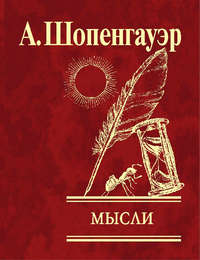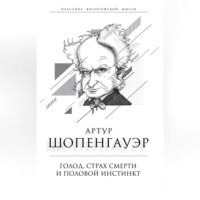 полная версия
полная версияThe World as Will and Idea (Vol. 1 of 3)
If now we consider architecture simply as a fine art and apart from its application to useful ends, in which it serves the will and not pure knowledge, and therefore ceases to be art in our sense; we can assign to it no other aim than that of bringing to greater distinctness some of those ideas, which are the lowest grades of the objectivity of will; such as gravity, cohesion, rigidity, hardness, those universal qualities of stone, those first, simplest, most inarticulate manifestations of will; the bass notes of nature; and after these light, which in many respects is their opposite. Even at these low grades of the objectivity of will we see its nature revealing itself in discord; for properly speaking the conflict between gravity and rigidity is the sole æsthetic material of architecture; its problem is to make this conflict appear with perfect distinctness in a multitude of different ways. It solves it by depriving these indestructible forces of the shortest way to their satisfaction, and conducting them to it by a circuitous route, so that the conflict is lengthened and the inexhaustible efforts of both forces become visible in many different ways. The whole mass of the building, if left to its original tendency, would exhibit a mere heap or clump, bound as closely as possible to the earth, to which gravity, the form in which the will appears here, continually presses, while rigidity, also objectivity of will, resists. But this very tendency, this effort, is hindered by architecture from obtaining direct satisfaction, and only allowed to reach it indirectly and by roundabout ways. The roof, for example, can only press the earth through columns, the arch must support itself, and can only satisfy its tendency towards the earth through the medium of the pillars, and so forth. But just by these enforced digressions, just by these restrictions, the forces which reside in the crude mass of stone unfold themselves in the most distinct and multifarious ways; and the purely æsthetic aim of architecture can go no further than this. Therefore the beauty, at any rate, of a building lies in the obvious adaptation of every part, not to the outward arbitrary end of man (so far the work belongs to practical architecture), but directly to the stability of the whole, to which the position, dimensions, and form of every part must have so necessary a relation that, where it is possible, if any one part were taken away, the whole would fall to pieces. For just because each part bears just as much as it conveniently can, and each is supported just where it requires to be and just to the necessary extent, this opposition unfolds itself, this conflict between rigidity and gravity, which constitutes the life, the manifestation of will, in the stone, becomes completely visible, and these lowest grades of the objectivity of will reveal themselves distinctly. In the same way the form of each part must not be determined arbitrarily, but by its end, and its relation to the whole. The column is the simplest form of support, determined simply by its end: the twisted column is tasteless; the four-cornered pillar is in fact not so simple as the round column, though it happens that it is easier to make it. The forms also of frieze, rafter, roof, and dome are entirely determined by their immediate end, and explain themselves from it. The decoration of capitals, &c., belongs to sculpture, not to architecture, which admits it merely as extraneous ornament, and could dispense with it. According to what has been said, it is absolutely necessary, in order to understand the æsthetic satisfaction afforded by a work of architecture, to have immediate knowledge through perception of its matter as regards its weight, rigidity, and cohesion, and our pleasure in such a work would suddenly be very much diminished by the discovery that the material used was pumice-stone; for then it would appear to us as a kind of sham building. We would be affected in almost the same way if we were told that it was made of wood, when we had supposed it to be of stone, just because this alters and destroys the relation between rigidity and gravity, and consequently the significance and necessity of all the parts, for these natural forces reveal themselves in a far weaker degree in a wooden building. Therefore no real work of architecture as a fine art can be made of wood, although it assumes all forms so easily; this can only be explained by our theory. If we were distinctly told that a building, the sight of which gave us pleasure, was made of different kinds of material of very unequal weight and consistency, but not distinguishable to the eye, the whole building would become as utterly incapable of affording us pleasure as a poem in an unknown language. All this proves that architecture does not affect us mathematically, but also dynamically, and that what speaks to us through it, is not mere form and symmetry, but rather those fundamental forces of nature, those first Ideas, those lowest grades of the objectivity of will. The regularity of the building and its parts is partly produced by the direct adaptation of each member to the stability of the whole, partly it serves to facilitate the survey and comprehension of the whole, and finally, regular figures to some extent enhance the beauty because they reveal the constitution of space as such. But all this is of subordinate value and necessity, and by no means the chief concern; indeed, symmetry is not invariably demanded, as ruins are still beautiful.
Works of architecture have further quite a special relation to light; they gain a double beauty in the full sunshine, with the blue sky as a background, and again they have quite a different effect by moonlight. Therefore, when a beautiful work of architecture is to be erected, special attention is always paid to the effects of the light and to the climate. The reason of all this is, indeed, principally that all the parts and their relations are only made clearly visible by a bright, strong light; but besides this I am of opinion that it is the function of architecture to reveal the nature of light just as it reveals that of things so opposite to it as gravity and rigidity. For the light is intercepted, confined, and reflected by the great opaque, sharply outlined, and variously formed masses of stone, and thus it unfolds its nature and qualities in the purest and clearest way, to the great pleasure of the beholders, for light is the most joy-giving of things, as the condition and the objective correlative of the most perfect kind of knowledge of perception.
Now, because the Ideas which architecture brings to clear perception, are the lowest grades of the objectivity of will, and consequently their objective significance, which architecture reveals to us, is comparatively small; the æsthetic pleasure of looking at a beautiful building in a good light will lie, not so much in the comprehension of the Idea, as in the subjective correlative which accompanies this comprehension; it will consist pre-eminently in the fact that the beholder, set free from the kind of knowledge that belongs to the individual, and which serves the will and follows the principle of sufficient reason, is raised to that of the pure subject of knowing free from will. It will consist then principally in pure contemplation itself, free from all the suffering of will and of individuality. In this respect the opposite of architecture, and the other extreme of the series of the fine arts, is the drama, which brings to knowledge the most significant Ideas. Therefore in the æsthetic pleasure afforded by the drama the objective side is throughout predominant.
Architecture has this distinction from plastic art and poetry: it does not give us a copy but the thing itself. It does not repeat, as they do, the known Idea, so that the artist lends his eyes to the beholder, but in it the artist merely presents the object to the beholder, and facilitates for him the comprehension of the Idea by bringing the actual, individual object to a distinct and complete expression of its nature.
Unlike the works of the other arts, those of architecture are very seldom executed for purely æsthetic ends. These are generally subordinated to other useful ends which are foreign to art itself. Thus the great merit of the architect consists in achieving and attaining the pure æsthetic ends, in spite of their subordination to other ends which are foreign to them. This he does by cleverly adapting them in a variety of ways to the arbitrary ends in view, and by rightly judging which form of æsthetical architectonic beauty is compatible and may be associated with a temple, which with a palace, which with a prison, and so forth. The more a harsh climate increases these demands of necessity and utility, determines them definitely, and prescribes them more inevitably, the less free play has beauty in architecture. In the mild climate of India, Egypt, Greece, and Rome, where the demands of necessity were fewer and less definite, architecture could follow its æsthetic ends with the greatest freedom. But under a northern sky this was sorely hindered. Here, when caissons, pointed roofs and towers were what was demanded, architecture could only unfold its own beauty within very narrow limits, and therefore it was obliged to make amends by resorting all the more to the borrowed ornaments of sculpture, as is seen in Gothic architecture.
We thus see that architecture is greatly restricted by the demands of necessity and utility; but on the other hand it has in them a very powerful support, for, on account of the magnitude and costliness of its works, and the narrow sphere of its æsthetic effect, it could not continue to exist merely as a fine art, if it had not also, as a useful and necessary profession, a firm and honourable place among the occupations of men. It is the want of this that prevents another art from taking its place beside architecture as a sister art, although in an æsthetical point of view it is quite properly to be classed along with it as its counterpart; I mean artistic arrangements of water. For what architecture accomplishes for the Idea of gravity when it appears in connection with that of rigidity, hydraulics accomplishes for the same Idea, when it is connected with fluidity, i. e., formlessness, the greatest mobility and transparency. Leaping waterfalls foaming and tumbling over rocks, cataracts dispersed into floating spray, springs gushing up as high columns of water, and clear reflecting lakes, reveal the Ideas of fluid and heavy matter, in precisely the same way as the works of architecture unfold the Ideas of rigid matter. Artistic hydraulics, however, obtains no support from practical hydraulics, for, as a rule, their ends cannot be combined; yet, in exceptional cases, this happens; for example, in the Cascata di Trevi at Rome.53
§ 44. What the two arts we have spoken of accomplish for these lowest grades of the objectivity of will, is performed for the higher grades of vegetable nature by artistic horticulture. The landscape beauty of a scene consists, for the most part, in the multiplicity of natural objects which are present in it, and then in the fact that they are clearly separated, appear distinctly, and yet exhibit a fitting connection and alternation. These two conditions are assisted and promoted by landscape-gardening, but it has by no means such a mastery over its material as architecture, and therefore its effect is limited. The beauty with which it is concerned belongs almost exclusively to nature; it has done little for it; and, on the other hand, it can do little against unfavourable nature, and when nature works, not for it, but against it, its achievements are small.
The vegetable world offers itself everywhere for æsthetic enjoyment without the medium of art; but so far as it is an object of art, it belongs principally to landscape-painting; to the province of which all the rest of unconscious nature also belongs. In paintings of still life, and of mere architecture, ruins, interiors of churches, &c., the subjective side of æsthetic pleasure is predominant, i. e., our satisfaction does not lie principally in the direct comprehension of the represented Ideas, but rather in the subjective correlative of this comprehension, pure, will-less knowing. For, because the painter lets us see these things through his eyes, we at once receive a sympathetic and reflected sense of the deep spiritual peace and absolute silence of the will, which were necessary in order to enter with knowledge so entirely into these lifeless objects, and comprehend them with such love, i. e., in this case with such a degree of objectivity. The effect of landscape-painting proper is indeed, as a whole, of this kind; but because the Ideas expressed are more distinct and significant, as higher grades of the objectivity of will, the objective side of æsthetic pleasure already comes more to the front and assumes as much importance as the subjective side. Pure knowing as such is no longer the paramount consideration, for we are equally affected by the known Platonic Idea, the world as idea at an important grade of the objectification of will.
But a far higher grade is revealed by animal painting and sculpture. Of the latter we have some important antique remains; for example, horses at Venice, on Monte Cavallo, and on the Elgin Marbles, also at Florence in bronze and marble; the ancient boar, howling wolves, the lions in the arsenal at Venice, also in the Vatican a whole room almost filled with ancient animals, &c. In these representations the objective side of æsthetic pleasure obtains a marked predominance over the subjective. The peace of the subject which knows these Ideas, which has silenced its own will, is indeed present, as it is in all æsthetic contemplation; but its effect is not felt, for we are occupied with the restlessness and impetuosity of the will represented. It is that very will, which constitutes our own nature, that here appears to us in forms, in which its manifestation is not, as in us, controlled and tempered by intellect, but exhibits itself in stronger traits, and with a distinctness that borders on the grotesque and monstrous. For this very reason there is no concealment; it is free, naïve, open as the day, and this is the cause of our interest in animals. The characteristics of species appeared already in the representation of plants, but showed itself only in the forms; here it becomes much more distinct, and expresses itself not only in the form, but in the action, position, and mien, yet always merely as the character of the species, not of the individual. This knowledge of the Ideas of higher grades, which in painting we receive through extraneous means, we may gain directly by the pure contemplative perception of plants, and observation of beasts, and indeed of the latter in their free, natural, and unrestrained state. The objective contemplation of their manifold and marvellous forms, and of their actions and behaviour, is an instructive lesson from the great book of nature, it is a deciphering of the true signatura rerum.54 We see in them the manifold grades and modes of the manifestation of will, which in all beings of one and the same grade, wills always in the same way, which objectifies itself as life, as existence in such endless variety, and such different forms, which are all adaptations to the different external circumstances, and may be compared to many variations on the same theme. But if we had to communicate to the observer, for reflection, and in a word, the explanation of their inner nature, it would be best to make use of that Sanscrit formula which occurs so often in the sacred books of the Hindoos, and is called Mahavakya, i.e., the great word: “Tat twam asi,” which means, “this living thing art thou.”
§ 45. The great problem of historical painting and sculpture is to express directly and for perception the Idea in which the will reaches the highest grade of its objectification. The objective side of the pleasure afforded by the beautiful is here always predominant, and the subjective side has retired into the background. It is further to be observed that at the next grade below this, animal painting, the characteristic is entirely one with the beautiful; the most characteristic lion, wolf, horse, sheep, or ox, was always the most beautiful also. The reason of this is that animals have only the character of their species, no individual character. In the representation of men the character of the species is separated from that of the individual; the former is now called beauty (entirely in the objective sense), but the latter retains the name, character, or expression, and the new difficulty arises of representing both, at once and completely, in the same individual.
Human beauty is an objective expression, which means the fullest objectification of will at the highest grade at which it is knowable, the Idea of man in general, completely expressed in the sensible form. But however much the objective side of the beautiful appears here, the subjective side still always accompanies it. And just because no object transports us so quickly into pure æsthetic contemplation, as the most beautiful human countenance and form, at the sight of which we are instantly filled with unspeakable satisfaction, and raised above ourselves and all that troubles us; this is only possible because this most distinct and purest knowledge of will raises us most easily and quickly to the state of pure knowing, in which our personality, our will with its constant pain, disappears, so long as the pure æsthetic pleasure lasts. Therefore it is that Goethe says: “No evil can touch him who looks on human beauty; he feels himself at one with himself and with the world.” That a beautiful human form is produced by nature must be explained in this way. At this its highest grade the will objectifies itself in an individual; and therefore through circumstances and its own power it completely overcomes all the hindrances and opposition which the phenomena of the lower grades present to it. Such are the forces of nature, from which the will must always first extort and win back the matter that belongs to all its manifestations. Further, the phenomenon of will at its higher grades always has multiplicity in its form. Even the tree is only a systematic aggregate of innumerably repeated sprouting fibres. This combination assumes greater complexity in higher forms, and the human body is an exceedingly complex system of different parts, each of which has a peculiar life of its own, vita propria, subordinate to the whole. Now that all these parts are in the proper fashion subordinate to the whole, and co-ordinate to each other, that they all work together harmoniously for the expression of the whole, nothing superfluous, nothing restricted; all these are the rare conditions, whose result is beauty, the completely expressed character of the species. So is it in nature. But how in art? One would suppose that art achieved the beautiful by imitating nature. But how is the artist to recognise the perfect work which is to be imitated, and distinguish it from the failures, if he does not anticipate the beautiful before experience? And besides this, has nature ever produced a human being perfectly beautiful in all his parts? It has accordingly been thought that the artist must seek out the beautiful parts, distributed among a number of different human beings, and out of them construct a beautiful whole; a perverse and foolish opinion. For it will be asked, how is he to know that just these forms and not others are beautiful? We also see what kind of success attended the efforts of the old German painters to achieve the beautiful by imitating nature. Observe their naked figures. No knowledge of the beautiful is possible purely a posteriori, and from mere experience; it is always, at least in part, a priori, although quite different in kind, from the forms of the principle of sufficient reason, of which we are conscious a priori. These concern the universal form of phenomena as such, as it constitutes the possibility of knowledge in general, the universal how of all phenomena, and from this knowledge proceed mathematics and pure natural science. But this other kind of knowledge a priori, which makes it possible to express the beautiful, concerns, not the form but the content of phenomena, not the how but the what of the phenomenon. That we all recognise human beauty when we see it, but that in the true artist this takes place with such clearness that he shows it as he has never seen it, and surpasses nature in his representation; this is only possible because we ourselves are the will whose adequate objectification at its highest grade is here to be judged and discovered. Thus alone have we in fact an anticipation of that which nature (which is just the will that constitutes our own being) strives to express. And in the true genius this anticipation is accompanied by so great a degree of intelligence that he recognises the Idea in the particular thing, and thus, as it were, understands the half-uttered speech of nature, and articulates clearly what she only stammered forth. He expresses in the hard marble that beauty of form which in a thousand attempts she failed to produce, he presents it to nature, saying, as it were, to her, “That is what you wanted to say!” And whoever is able to judge replies, “Yes, that is it.” Only in this way was it possible for the genius of the Greeks to find the type of human beauty and establish it as a canon for the school of sculpture; and only by virtue of such an anticipation is it possible for all of us to recognise beauty, when it has actually been achieved by nature in the particular case. This anticipation is the Ideal. It is the Idea so far as it is known a priori, at least half, and it becomes practical for art, because it corresponds to and completes what is given a posteriori through nature. The possibility of such an anticipation of the beautiful a priori in the artist, and of its recognition a posteriori by the critic, lies in the fact that the artist and the critic are themselves the “in-itself” of nature, the will which objectifies itself. For, as Empedocles said, like can only be known by like: only nature can understand itself: only nature can fathom itself: but only spirit also can understand spirit.55
The opinion, which is absurd, although expressed by the Socrates of Xenophon (Stobæi Floril, vol. ii. p. 384) that the Greeks discovered the established ideal of human beauty empirically, by collecting particular beautiful parts, uncovering and noting here a knee, there an arm, has an exact parallel in the art of poetry. The view is entertained, that Shakespeare, for example, observed, and then gave forth from his own experience of life, the innumerable variety of the characters in his dramas, so true, so sustained, so profoundly worked out. The impossibility and absurdity of such an assumption need not be dwelt upon. It is obvious that the man of genius produces the works of poetic art by means of an anticipation of what is characteristic, just as he produces the works of plastic and pictorial art by means of a prophetic anticipation of the beautiful; yet both require experience as a pattern or model, for thus alone can that which is dimly known a priori be called into clear consciousness, and an intelligent representation of it becomes possible.
Human beauty was explained above as the fullest objectification of will at the highest grade at which it is knowable. It expresses itself through the form; and this lies in space alone, and has no necessary connection with time, as, for example, motion has. Thus far then we may say: the adequate objectification of will through a merely spatial phenomenon is beauty, in the objective sense. A plant is nothing but such a merely spatial phenomenon of will; for no motion, and consequently no relation to time (regarded apart from its development), belongs to the expression of its nature; its mere form expresses its whole being and displays it openly. But brutes and men require, further, for the full revelation of the will which is manifested in them, a series of actions, and thus the manifestation in them takes on a direct relation to time. All this has already been explained in the preceding book; it is related to what we are considering at present in the following way. As the merely spatial manifestation of will can objectify it fully or defectively at each definite grade, – and it is this which constitutes beauty or ugliness, – so the temporal objectification of will, i. e., the action, and indeed the direct action, the movement, may correspond to the will, which objectifies itself in it, purely and fully without foreign admixture, without superfluity, without defect, only expressing exactly the act of will determined in each case; – or the converse of all this may occur. In the first case the movement is made with grace, in the second case without it. Thus as beauty is the adequate representation of will generally, through its merely spatial manifestation; grace is the adequate representation of will through its temporal manifestation, that is to say, the perfectly accurate and fitting expression of each act of will, through the movement and position which objectify it. Since movement and position presuppose the body, Winckelmann's expression is very true and suitable, when he says, “Grace is the proper relation of the acting person to the action” (Works, vol. i. p. 258). It is thus evident that beauty may be attributed to a plant, but no grace, unless in a figurative sense; but to brutes and men, both beauty and grace. Grace consists, according to what has been said, in every movement being performed, and every position assumed, in the easiest, most appropriate and convenient way, and therefore being the pure, adequate expression of its intention, or of the act of will, without any superfluity, which exhibits itself as aimless, meaningless bustle, or as wooden stiffness. Grace presupposes as its condition a true proportion of all the limbs, and a symmetrical, harmonious figure; for complete ease and evident appropriateness of all positions and movements are only possible by means of these. Grace is therefore never without a certain degree of beauty of person. The two, complete and united, are the most distinct manifestation of will at the highest grade of its objectification.









